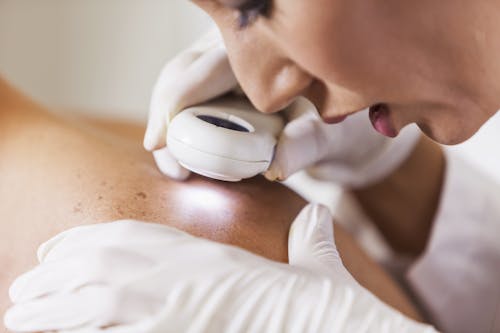On 02
Mar
2023

Skin Cancers are some of the most common forms of cancer, however, not all skin cancers are the same. The three most prominent types of skin cancer are basal cell carcinoma, squamous cell carcinoma, and melanoma. Statistically speaking, one in five Americans will develop skin cancer by the age of 70. Furthermore, every hour, in the United States, more than two people die of skin cancer. In addition, your risk of developing melanoma is doubled by having five or more sunburns. So how do you reduce your chances of getting skin cancer?
I can’t emphasize this enough, but practicing sun safety is paramount to reducing your chances of getting skin cancer. Limiting your exposure to UV rays (ultraviolet radiation) all year is important, not just during the summertime. UV rays have the ability to affect your skin even on cool and cloudy days. Moreover, they can reflect off of surfaces like snow, water, sand, and cement. So how do you reduce your exposure to UV rays? Well, according to the CDC, you can protect your skin by staying in the shade, wearing clothes that conceal your arms and legs, wearing a hat to shade your face, and using broad-spectrum sunscreen with an SPF (sun protection factor) of 15 or higher. Another big thing to avoid is indoor tanning which exposes you to intense levels of UV rays. As a side note, indoor tanning accidents result in over 3000 emergency room visits a year!
So, what happens if you do get skin cancer? Well, that really depends on the type of skin cancer. Variables such as the size, depth, and location of the lesion can dictate management. If you happen to be diagnosed with actinic keratosis, for example, a precancerous lesion, treatment can be as simple as freezing it with liquid nitrogen, otherwise known as cryotherapy, and routine cancer surveillance. Now, if you are diagnosed with actual skin cancer (basal cell carcinoma, squamous cell carcinoma, or melanoma), a more extensive approach to treatment is warranted. Mohs micrographic surgery is the most commonly performed procedure for the removal of larger, recurrent skin cancers. The premise behind this approach is to remove the skin cancer while preserving as much skin as possible to limit the extent of scarring and obtain the best possible cosmetic outcome. During surgery, the cancer is removed layer by layer and examined under a microscope until no cancerous cells are seen. The resulting defect is then repaired at a later date. I often get asked why the reconstruction is not just performed on the same day. There are two main reasons for this; first, there is an abundance of evidence that supports delaying reconstruction to allow healthy, viable tissue to grow within the wound, thereby limiting the incidence of infection, and optimizing the outcome of surgery. Second, it is to ensure that the entirety of cancer has indeed been excised. We will wait until a final pathology report is provided confirming the absence of any abnormal cells before proceeding with the reconstruction. Another approach to skin cancer treatment is Curettage and Electrodesiccation. This entails scraping away layers of cancer cells with a blade and subsequent destruction of any remaining cells using electrocautery.
Alternative treatments for skin cancer include radiation therapy, chemotherapy, photodynamic therapy, and biological therapy. These approaches are generally reserved for cancer that cannot be managed or completely removed by surgery alone and involve a multidisciplinary approach. Radiation therapy involves the use of high-powered beams of energy to eliminate cancer cells. Chemotherapy uses various drugs, either topical (applied to the skin) or systemic (delivered into the bloodstream) to kill cancer cells. Photodynamic therapy involves the use of certain drugs that make cancer cells sensitive to light, followed by laser light treatment that destroys those cells. Biological therapy aims at getting your body’s own immune system to get rid of cancer cells.
We are very privileged to be able to offer state-of-the-art surgical treatments for our skin cancer patients performed by our very talented group of surgeons to restore form and function. I always tell my patients; the ultimate goal is to ensure that nobody else knows that you’ve had anything done. It is truly a gift to be able to help patients on their cancer journey and for them to have the confidence that they care every step of the way. At our practice, your skin will be thoroughly evaluated and treatment options discussed to come up with the best possible plan that is most effective for you and that will yield the best possible outcome. To get started, please don’t hesitate to reach out to us and set up an appointment at either of our Melbourne, Florida, or Merritt Island, Florida locations.

